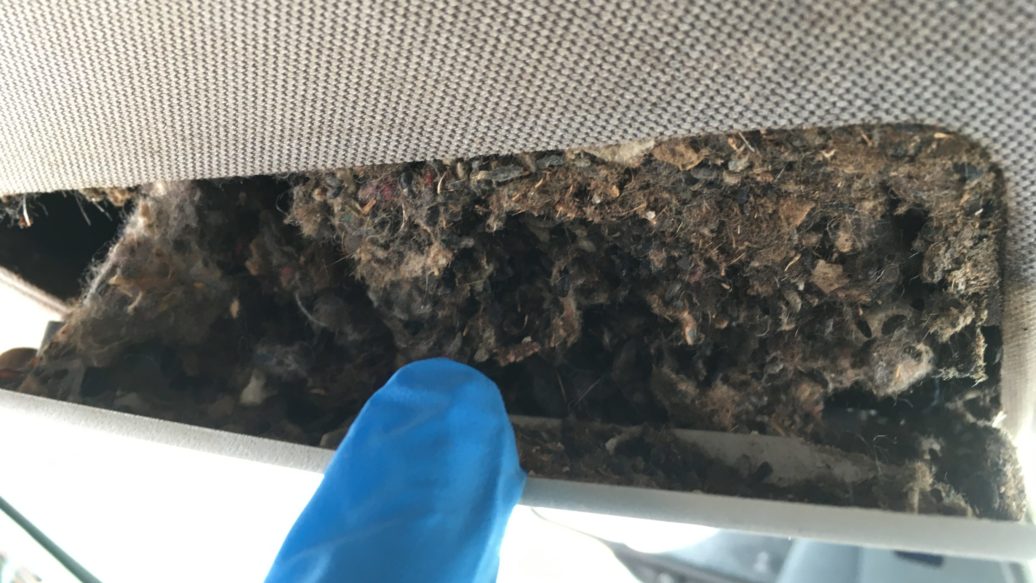As long-time readers know, I’ve repeatedly referenced borrowing “the work truck” to occasionally tow cars. Said work truck is a 2008 Chevy Silverado 3500HD duallie with a utility body and the highly-desirable towing package with the Duramax diesel and Allison six-speed automatic transmission. My old engineering job bought it new in order to tow geophysical surveying equipment housed in a 32-foot trailer. I drove the truck and trailer quite a bit myself back and forth to job sites.
That work, however, trended down around 2014, after which the truck largely sat with only 28,000 miles on it. Although I left my engineering job in 2015 and became a full-time writer (first at Bentley Publishers, then self-employed), I remained a consultant, and as a favor to them (which also had a large degree of enlightened self-interest), I kept the work truck and trailer legal on my own time by renewing their registrations, fixing minor inspection-related issues, and getting their annual inspections done. I also drove the truck regularly to keep it exercised, and had an informal quid pro quo with my longtime supervisor that this exercise could extend to using it to move my kids in and out of apartments, transporting an engine, picking up lumber, or towing a car. Since I had sold the last in a line of Suburbans in 2016, this, obviously, was a handy free spin card to have.
Having access to an incredibly capable truck that I didn’t own was a pretty sweet situation, but the truck’s sitting took its toll: Mice got in and nested in the heater box. At first it was largely a minor annoyance, as turning on the heat or a/c caused bits of wool to fly forth from the vents, but then the stench settled in. When I last used the truck to tow Hampton, the 49,000-mile 2002 that I bought on Long Island two years ago, I had to leave the a/c off and the windows down for the entire 400-mile drive.

The work truck tows Hampton: handy, but fragrant.
As the years went by and the company reorganized, they seemed largely unaware of the truck’s existence, other than once a year when its $700-a-month parking expense—$350 each for the truck and trailer, necessary because a zoning issue prevented them from being parked at the work building—raised eyebrows. It eventually became clear that things were on a trajectory for them to divest themselves of all of the old geophysical equipment, including the truck and trailer.
I made them a low offer on the truck, and initially they accepted it, but then someone found it on an asset sheet and determined that the undepreciated portion of its value was twelve grand. They asked me if I’d raise my offer. I inched it up a bit, but got no response.
I thought that was that.
Early this spring I went to the commercial lot where the truck was parked in order to start it and drive it around, and found that the mouse situation had absolutely exploded: The stench was enough to gag a vulture. Mice had gotten into the headliner, and a disgusting brown fluid was oozing down from the map-light panel.
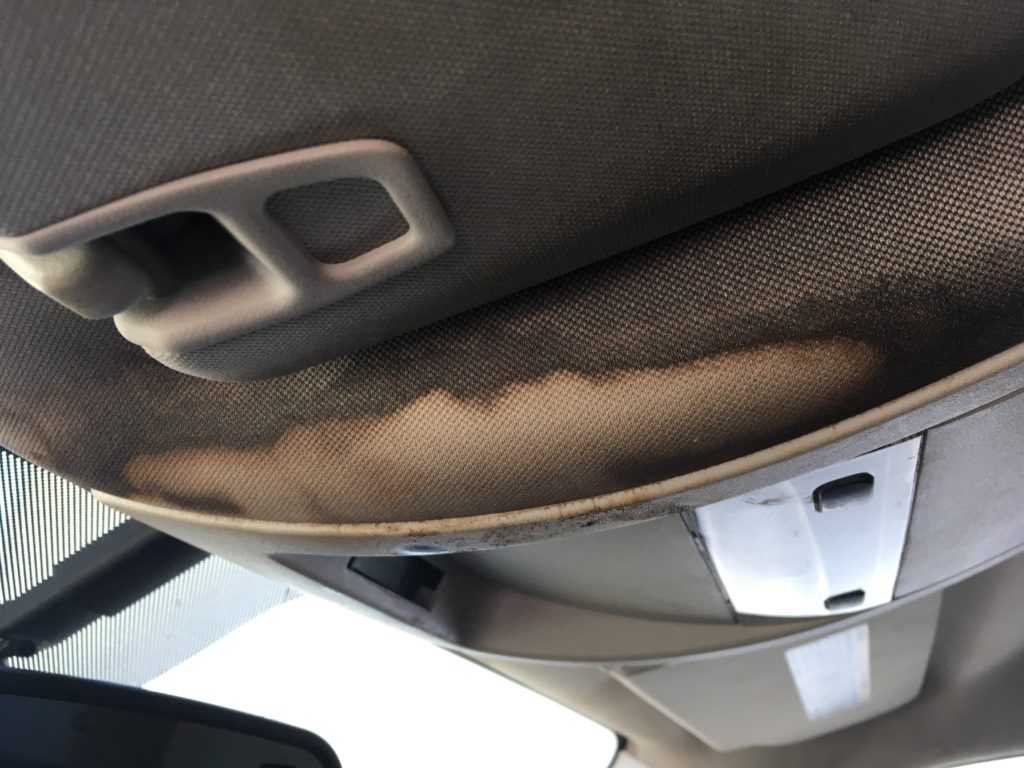
I suppose you could try to delude yourself into thinking this was some sort of water staining…
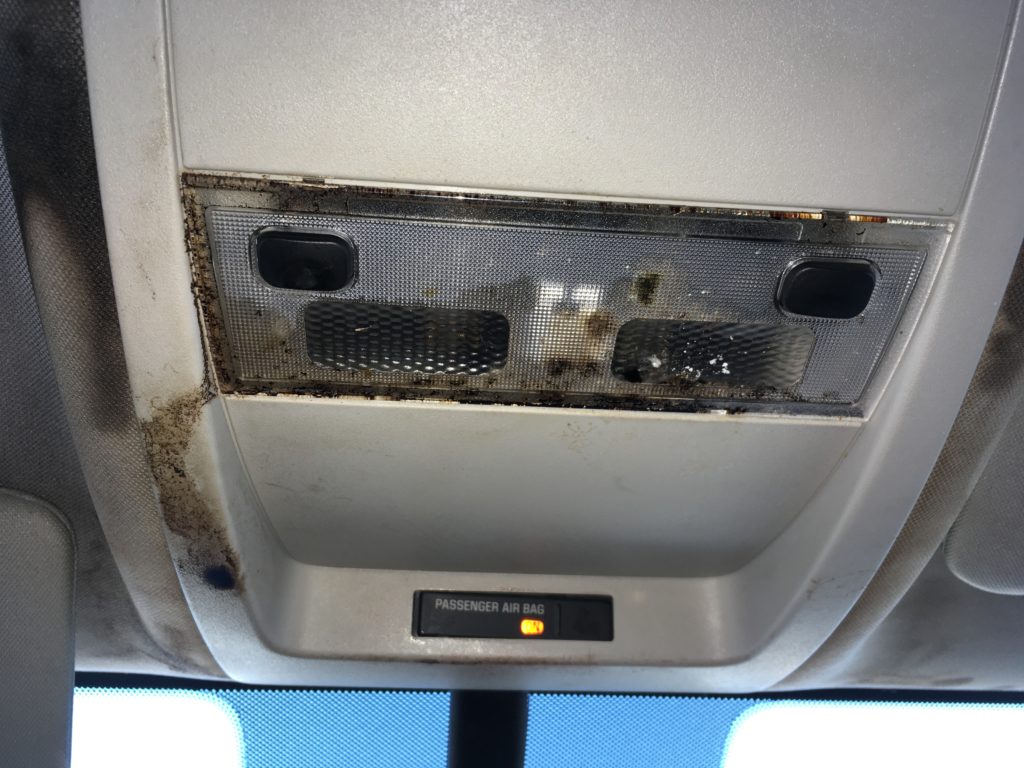
… but there was no denying what the source of this really was.
Shortly after that, the company abruptly closed the building I’d worked in and liquidated the equipment inside. The truck was likely only spared the fire sale because it was parked in its commercial lot about two miles away.
I thought about it carefully. The stench and filth notwithstanding, I certainly could use a truck… and it did run. And not that I had a scintilla of interest in parting it out, but a 28,000-mile Duramax diesel engine by itself is probably worth ten grand, so the risk was actually pretty low.
I sent the company an email describing the horrific degree of mouse contamination, including photos of the oozing headliner (and the not-disgusting-but-not-inexpensive need for six new tires), and gave them a $2,000 take-it-or-leave-it offer, making the dispassionate but accurate case that as the long-time user and caretaker of the truck, if anyone was going to pick it up at a fire-sale price, it should be me. I also let them know that I had all the truck’s paperwork, so I could make it go away in an instant; all I needed from them was a bill of sale documenting that they’d sold it to me and an address to send the check to. Finally, I gently reminded them that if they’d accepted the first offer I’d made them last year, they would’ve saved themselves $4,200 in parking costs.
It took a few months, but they acquiesced, and in July, the mouse-infested 2008 Silverado 3500HD duallie Duramax with 28,000 miles on it was mine for the yeah-I-just-stole-it price of $2,000.
As I’ve written here, my home state of Massachusetts charges sales tax not on what you paid, but on the NADA low book value, and the NADA guide certainly knows what a 28,000-mile 3500HD Duramax is worth, so when I paid the taxes and fees to the registry, I forked over 3/4 of what I’d just paid for the truck. Add the six tires that it needs and you’re at five grand—but still, a steal.
I drove the reeking truck the eight miles home with the windows down and a mask on, parked it in my driveway where I barely have room for it, and wondered what the hell I’d just done.
Ten years ago, in the July 2011 Roundel, I wrote a piece called “The Bad Mouse Warehouse” (get it?), in which I described looking at a Hartge-massaged Euro 635CSi being sold cheaply because it was dead and mouse-infested. Even though I badly wanted a Euro E24, I walked away because my lust for the car didn’t even come close to overcoming the revulsion for working around that level of filth and stench. So what the hell did I think I was doing buying this truck? I’m not even remotely a truck guy. I am, however, an enormously practical person with a pretty damn good track record of getting things done, if I say so myself.
Although mouse contamination is like rust in that what you see is likely only the tip of the iceberg, it was obvious that the mother lodes were in the headliner and the heater box. My basic strategy was:
- Remove the mother lodes.
- Clean or replace anything they touched with enzyme-based cleaner.
- Follow up with treatment of the entire interior with a consumer-quality ozone generator.
- Keep the expectations realistic and the scope manageable. This isn’t a ’63 Series I Jaguar E-Type or another vintage car that I want to bring back to its former glory. It’s never going to be an enthusiast vehicle, a pleasure vehicle, a daily driver, or even something I’m going to drive often. And my wife, she of the hyper-sensitive sense of smell, was unlikely to ever ride in it.
So there’s going to be a cap on the amount of work I’m willing to do. I’m not going to strip the cabin bare. My Lotus Europa sat for 40 years and had some minor mouse-contamination issues that I addressed, but even now, if the Lotus sits with the windows up in the heat, you can still catch a whiff of rodent. If I can get the truck to a similar place—specifically, if I can get it to the point where I can drive it with the windows up and the a/c on, even if it’s still a little fragrant—that would be acceptable to me. That would be success. I just need to be able to use it to tow an occasional car in something approximating comfort.
So, with expectations managed, I had at it.
First, let me say that yes, I did take the possibility of hantavirus seriously, but when I looked into it, it’s essentially non-existent in Massachusetts (one case in 1992 which was likely contracted in another state). So yes, I wore a mask and gloves, but not a respirator and a moon suit.
I began by pulling the headliner. Unlike vintage BMWs, in which headliner replacement is a tedious upholstery-specific operation, in the truck, it was just unbolting things like visors, map lights, and seat-belt attachment points, popping out a few snap-in fasteners, and simply dropping the thing down. It revealed, to absolutely no surprise, that what was causing the staining and dripping was a foul accumulation of mouse feces, and that the stench was augmented by the presence of several mouse carcasses, together contributing the base note and the top note to the perfume Eau de Rodentia. (By the way, if you’re wondering how mice can get into the headliner, the A-pillars of the truck are big enough that they’re the mouse equivalent of those people-transport tubes in Futurama.)

It came out easily…
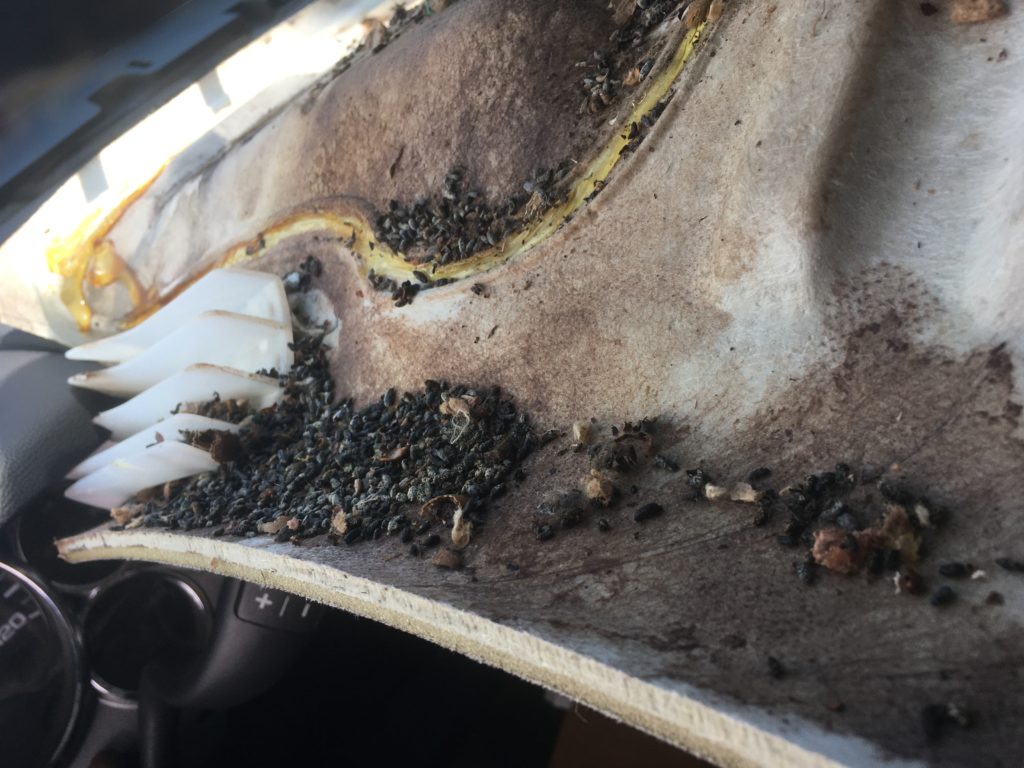
…and what it revealed was disgusting but not unexpected.
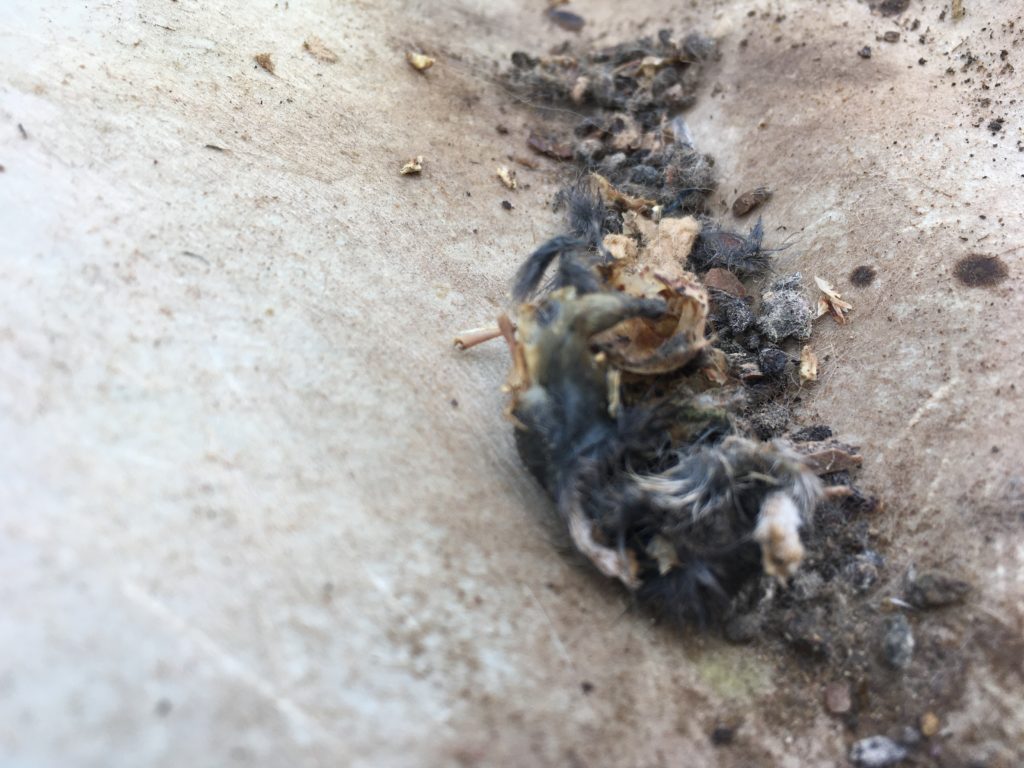
Him, too. No wonder the cabin absolutely stank.
Since the stains went clear through through the multiple layers of fiberglass, foam, and cloth, there was no way I was going to attempt cleaning the just-removed headliner, so I needed to find a replacement. I’m not at all conversant with the GM parts catalog and the websites that serve it up, so it took me a while to navigate through it and understand that I needed the part number for a headliner that matched the work truck’s Spartan options package (extended cab, no sunroof, no head airbags, no rear entertainment system, and no rear climate control). I eventually found it—part number 19352360 for a 2007-to-2011 Chevy Silverado/GMC Sierra, list price about $760, discounted list about $550—but the thing is the size of the cab, so shipping was quoted at nearly three hundred bucks.
I’ve been aware of the nationwide junkyard-connected website Car-Part.com for a while. I’ve used it look for a Boston Green front bumper cover in a local-ish junkyard for my Z3 (like the headliner, shipping a bumper cover is a killer). I entered the truck’s information, checked off the options that specified the headliner, and bam! Up popped a compatible headliner in nearby Woonsocket, Rhode Island for only $150. I called, asked a few questions, gave then my credit card, and they said they’d call me when it was pulled.
While I was waiting, I thoroughly cleaned the exposed roof and pillars, as well as the rodent-drenched map light panel, with Rocco and Roxie Professional Strength Stain and Odor Eliminator (selected because of its reviews on Amazon, it worked great).
The following Monday the junkyard called me, saying that the headliner was ready for pickup. I drove down, grabbed the headliner, gave it a quick cleaning (I used Chemical Guys Upholstery and Stain Extractor, which I also would highly recommend), and in about an hour and a half, had it installed.
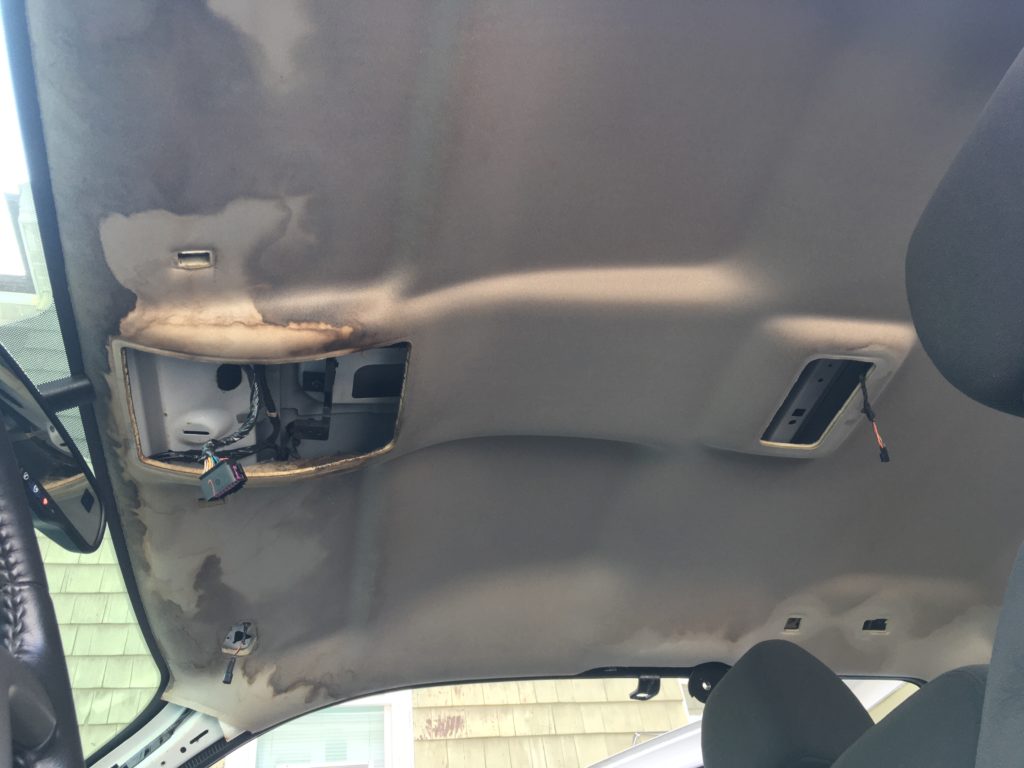
Before replacement…

… and after.
With the carnage in the headliner addressed, the next task was physically more contained but likely far more challenging: de-mousing the heater box. Next week, in I go.—Rob Siegel
Rob’s new book, The Best of The Hack Mechanic, is available here on Amazon, as are his seven other books. Signed copies can be ordered directly from Rob here.

